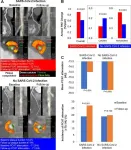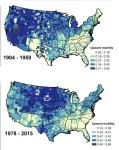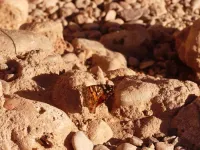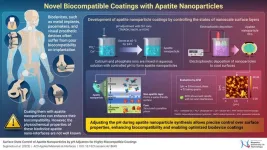Visualization of chemical phenomena in the microscopic world using semiconductor image sensor
~Aiming at the elucidation of brain functions and medical applications~
2025-02-04
(Press-News.org)
<Overview>
A research team led by Professor Kazuaki Sawada and Project Assistant Professor Hideo Doi of the Department of Electrical and Electronic Information Engineering, Toyohashi University of Technology has developed a semiconductor sensor enabling the real-time observation of two types of biomolecule dynamics in solutions. By using semiconductor technology to pattern a thin metal film functioning as a neurotransmitter-sensitive membrane on sensor pixels arranged two-dimensionally in a 2 µm pitch, the sensor captures the movement of hydrogen ions and lactate (neurotransmitters) in a solution as image data. A time resolution of milliseconds and a spatial resolution of several microns (approximately 1/17 the size of a strand of hair) were achieved, and it is expected that the measurement of relation for neurotransmitters and ions distribution which changes temporally and spatially between cells with high spatiotemporal resolution.
<Details>
The brain mainly consists approximately 100 billion neurons and ten times as many non-neuronal cells (Glial cells). Action potentials generated by neurons are converted into electrical signals, transmitting information between cells. There are tiny gaps in the cell to cell junctions, and chemical substances called neurotransmitters or ions migrate between them, playing an important role in the control of brain function as chemical signals and being deeply involved in the pathophysiology of the brain. To investigate the detailed functions and pathology of the brain based on the elucidation of the transmission mechanism of chemical signals, the development of a bioimaging technology that visualizes and measures the spatiotemporal dynamics of chemical substances distributed in the extracellular space from a few microns (cellular level) to a few 100 µm (cellular population level). However, most conventional devices for chemical signal detection are of a type that has a single tiny electrode of diameter several tens of microns, or electrodes arranged at intervals of several 100 microns, and pass electric current, rendering them difficult to miniaturize and downsize. Consequently, sensors that measure the distribution of chemical information at the micron level have not been realized.
Professor Sawada's laboratory has previously developed a semiconductor image sensor that captures ion movement like a camera. This was achieved by miniaturizing and integrating potentiometric sensor pixel elements for hydrogen ion detection using semiconductor technology, with ongoing efforts to enhance the sensor's functionality. The researchers fabricated an imaging device for multisensing in which metal electrodes are formed in a lattice shape at intervals of 6 µm on the developed sensor array, and realized the real-time simultaneous measurement of lactate and hydrogen ions involved in memory formation by applying a recognition element (enzyme) that selectively detects biomolecules. In addition, recognition elements corresponding to biomolecules can be also patterned on the electrode array, enabling the simultaneous multichemical measurement of more than two types of neurotransmitters.
In the past, one type of biomolecule was measured with a single-point electrode, or one to three types of biomolecules were measured with an electrode array sensor with low spatial resolution. The newly developed feature of “capturing, visualizing, and measuring” two types of chemicals on a surface with high spatial resolution enables the detection of chemical signals in microscopic regions, such as between cells, along with spatiotemporal analysis. This advancement offers insights into chemical phenomena that were previously inaccessible using point-based sensors. In a collaborative experiment with researchers from the Faculty of Medicine, University of Yamanashi, experts in brain science and pharmacology, the response of hippocampal cells (responsible for memory) to drug stimulation was observed. The researchers simultaneously measured lactate release and extracellular pH. This breakthrough enables direct placement and measurement of cells and tissues without any labeling, allowing observation of spatiotemporal changes in ions and neurotransmitters, in biological samples. Building on this world-first ion image sensor technology, the team aims to advance its development for social implementation and medical applications.
<Future prospects>
We plan to proceed with the further enhancement of the functionality and performance of sensors to expand the range of substances to be measured. Using brain slice and solid tumor-like diseased tissue, we will conduct applied measurements to elucidate the physiological significance of temporal and spatial changes in molecular dynamics within the extracellular environment. Furthermore, this technology holds potential for analyzing interactions among chemical substances in the complex extracellular microenvironment and verifying pharmacological effects.
<Paper information>
Hideo Doi, Hayato Muraguchi, Tomoko Horio, Young-Joon Choi, Kazuhiro Takahashi, Toshihiko Noda, Kazuaki Sawada, “Real-time simultaneous visualization of lactate and proton dynamics using a 6-µm-pitch CMOS multichemical image sensor”, Biosensors and Bioelectronics, Vol.268, 116898. DOI:10.1016/j.bios.2024.116898
END
[Attachments] See images for this press release:
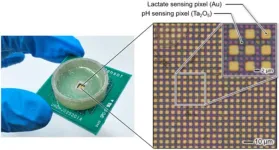
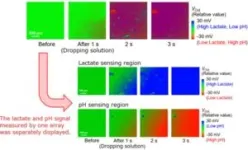
ELSE PRESS RELEASES FROM THIS DATE:
2025-02-04
OAK BROOK, Ill. – A new study found severe acute respiratory syndrome coronavirus 2 (SARS-CoV-2) infection was associated with the rapid growth of plaque in the coronary arteries and an increased risk of cardiovascular events. The results were published today in Radiology, a journal of the Radiological Society of North America (RSNA).
“COVID-19, caused by SARS-CoV-2, is initially characterized by acute lung injury and respiratory failure,” said the study’s senior author, Junbo Ge, M.D., professor and director of the Cardiology Department at Zhongshan Hospital, Fudan University in Shanghai, ...
2025-02-04
New assessment warns area the size of the USA will become too hot during extreme heat events for even healthy young humans to maintain a safe body temperature if we hit 2°C above preindustrial levels.
For those aged over 60, the same 2°C rise would see more than a third of the planet’s land mass cross this critical ‘overheating’ threshold
An international group of scientists, led by King’s College London, has revealed how continued global warming will lead to more parts of the planet becoming too ...
2025-02-04
INDIANAPOLIS -- Addressing patients’ health-related social needs such as housing instability, food insecurity, transportation barriers and financial strain is important to improving health outcomes yet can be challenging. A new study from Regenstrief Institute and Indiana University Indianapolis Richard M. Fairbanks School of Public Health investigates the best approach to predicting likely need for one or more health-related social need services.
To identify emergency department (E.D.) patients needing these services, researchers ...
2025-02-04
WASHINGTON—Body-weight cycling (also known as yo-yo dieting) has been shown to significantly increase the risk of kidney disease in people with type 1 diabetes, regardless of body mass index (BMI) and other traditional risk factors, according to a new study published in the Endocrine Society’s Journal of Clinical Endocrinology & Metabolism.
Yo-yo dieting is defined as repeatedly losing and gaining weight multiple times over the years. Its prevalence is reported to be as high as 35% in men and 55% in women.
This patten of dieting has been shown to increase risks of cardiovascular events ...
2025-02-04
A study combining remote sensing and administrative data finds that since the mid-20th century, large, growing cities have ceased to be centers of upward social and economic mobility.
Cities have been celebrated as places of innovation and social mobility but also as hotspots of inequality and poverty. Dylan Shane Connor and colleagues measured how the size, density, and connectedness of urban areas in an American’s birth county predicted their social mobility across the 20th century. The results tell a tale of a waning relationship between ...
2025-02-04
People who feel financially comfortable are more likely to report prosocial actions like donating money and prosocial attitudes than people in a tough financial situation, according to a study. Prosociality—preferences and behaviors that benefit others—is essential to human society. In practice, it is determined by both the desire and the ability to help. Paul Vanags and colleagues analyzed data from the Global Preferences Survey and the Gallup World Poll, including 80,337 people in 76 countries with incomes ranging from about $200 a year to about $380,000 per year, adjusted to be equivalent across the different countries ...
2025-02-04
A broadly distributed migratory butterfly travels varying distances, influenced by environmental conditions rather than following genetically coded instructions, according to a study. The Afro-Palearctic population of the painted lady butterfly, Vanessa cardui, is a single freely interbreeding, or ‘panmictic’ population.
Vanessa cardui is a renowned world traveler, undertaking multigenerational migrations throughout Africa, Asia, Europe, and North America. The winter breeding range of painted ladies in the Afro-Palearctic includes areas north and south of the Sahara ...
2025-02-04
Painted lady butterflies are world travelers. The ones we encounter in Europe fly from Africa to Sweden, ultimately returning to areas north and south of the Sahara. But what determines whether some butterflies travel long distances while others travel short distances? A group of scientists, including from the Institute of Science and Technology Austria (ISTA), shows that the different migration strategies are shaped by environmental conditions rather than being encoded in the butterfly’s DNA.
It is a warm summer day in June. A group of scientists with sunhats and nets is hiking along a trail in the Catalan mountains. They meticulously search for painted ladies—vibrant orange ...
2025-02-04
PLYMOUTH MEETING, PA [February 4, 2025] — The National Comprehensive Cancer Network® (NCCN®) is joining people and organizations across the globe to commemorate World Cancer Day today. World Cancer Day is a global initiative to improve awareness and knowledge of cancer risks and actions for better prevention, detection, and treatment. It is led and organized by the Union of International Cancer Control (UICC) every February 4.
World Cancer Day 2025 marks the start of the ‘United by Unique’ campaign to highlight how every experience with cancer is unique, even as people touched by cancer ...
2025-02-04
Medical implants have transformed healthcare, offering innovative solutions with advanced materials and technologies. However, many biomedical devices face challenges like insufficient cell adhesion, leading to inflammatory responses after their implantation in the body. Apatite coatings, particularly hydroxyapatite (HA)—a naturally occurring form of apatite found in bones, have been shown to promote better integration with surrounding tissues. However, the biocompatibility of artificially synthesized apatite nanoparticles often falls short of expectations, primarily due to the nanoparticles’ limited ability to bind effectively with biological tissues.
To overcome ...
LAST 30 PRESS RELEASES:
[Press-News.org] Visualization of chemical phenomena in the microscopic world using semiconductor image sensor
~Aiming at the elucidation of brain functions and medical applications~


